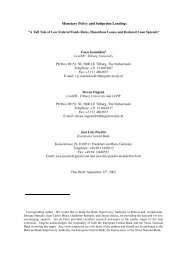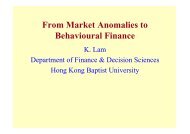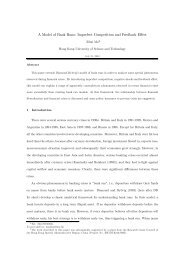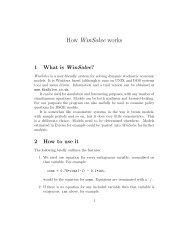Macroeconomics of the Franco-Prussian War Indemnity
Macroeconomics of the Franco-Prussian War Indemnity
Macroeconomics of the Franco-Prussian War Indemnity
You also want an ePaper? Increase the reach of your titles
YUMPU automatically turns print PDFs into web optimized ePapers that Google loves.
Hong Kong Institute for Monetary Research<br />
1. Introduction<br />
Research on <strong>the</strong> transfer problem tries to predict <strong>the</strong> economic effects <strong>of</strong> a unilateral, international<br />
transfer, generally among governments. Although it dates back to <strong>the</strong> nineteenth century, <strong>the</strong> debate<br />
about <strong>the</strong>se effects became best known with <strong>the</strong> Keynes-Ohlin controversy in <strong>the</strong> 1929 Economic Journal,<br />
which concerned German reparations after <strong>the</strong> 1914-1918 war. This debate focused mainly on <strong>the</strong><br />
effects on <strong>the</strong> donor, while more recent research has turned to development aid and been concerned<br />
with <strong>the</strong> effects on <strong>the</strong> recipient. Despite <strong>the</strong> transfer problem’s widespread appearance in textbooks on<br />
international economics, though, <strong>the</strong>re are very few quantitative studies <strong>of</strong> <strong>the</strong> effects <strong>of</strong> transfers, and<br />
none that uses a general equilibrium model that jointly predicts <strong>the</strong> terms <strong>of</strong> trade, <strong>the</strong> current account,<br />
welfare, and o<strong>the</strong>r macroeconomic variables.<br />
Our goal in this paper is to study <strong>the</strong> dynamic effects <strong>of</strong> a transfer, for two reasons. First, a transfer can<br />
be thought <strong>of</strong> as an experiment which should shed light on <strong>the</strong> way to build models in open-economy<br />
macroeconomics. For example, <strong>the</strong> response <strong>of</strong> <strong>the</strong> current account to <strong>the</strong> transfer may help us assess<br />
<strong>the</strong> intertemporal approach to <strong>the</strong> current account or <strong>the</strong> related question <strong>of</strong> how to model market<br />
incompleteness or limits on international risk-sharing. Similarly, <strong>the</strong> response <strong>of</strong> prices to <strong>the</strong> transfer<br />
should be informative about general equilibrium models <strong>of</strong> <strong>the</strong> terms <strong>of</strong> trade. 1<br />
Second, transfers play important roles in economic history. The specific transfer we study — <strong>the</strong> <strong>Franco</strong>-<br />
<strong>Prussian</strong> <strong>War</strong> indemnity — was blamed by popular historians for everything from <strong>the</strong> German stock<br />
market crash <strong>of</strong> 1873 to slow population growth in France. We embed <strong>the</strong> transfer in a general equilibrium<br />
model with o<strong>the</strong>r shocks to try to isolate <strong>the</strong> effects <strong>of</strong> <strong>the</strong> transfer. Historical transfers generally followed<br />
wars. Identifying <strong>the</strong> economic effects <strong>of</strong> <strong>the</strong> transfer or reparations requires that we control for o<strong>the</strong>r<br />
shocks, such as those to government spending during wartime.<br />
We argue below that a standard, open-economy, dynamic, general equilibrium model can contribute<br />
substantially to understanding <strong>the</strong> effect <strong>of</strong> <strong>the</strong> <strong>Franco</strong>-<strong>Prussian</strong> <strong>War</strong> indemnity. Using data from France<br />
during <strong>the</strong> 1860s and 1870s, we document <strong>the</strong> historical evolution <strong>of</strong> <strong>the</strong> key macroeconomic aggregates,<br />
including GDP, net exports, and <strong>the</strong> terms <strong>of</strong> trade. We also are able to isolate some <strong>of</strong> <strong>the</strong> key shocks<br />
during this period, including — but not exclusively — <strong>the</strong> transfer payment shock. While <strong>the</strong> transfer<br />
payment represented a huge macroeconomic shock to <strong>the</strong> French economy, <strong>the</strong> evidence suggests<br />
that <strong>the</strong>re were o<strong>the</strong>r large shocks at <strong>the</strong> time. We have enough data to identify shocks to government<br />
spending (fiscal policy) and to aggregate productivity. Using <strong>the</strong>se shocks, we can construct <strong>the</strong> model’s<br />
predictions for <strong>the</strong> sample paths <strong>of</strong> <strong>the</strong> French economy.<br />
The model is quite successful in accounting for <strong>the</strong> historical sample paths <strong>of</strong> <strong>the</strong> main macroeconomic<br />
aggregates. Both sets <strong>of</strong> shocks are necessary in this accounting, however. The transfer shock alone<br />
can account for <strong>the</strong> movements in <strong>the</strong> terms <strong>of</strong> trade and net exports, but cannot provide an adequate<br />
account <strong>of</strong> <strong>the</strong> path <strong>of</strong> GDP and aggregate consumption. On <strong>the</strong> o<strong>the</strong>r hand, fiscal and productivity<br />
shocks provide a reasonable account <strong>of</strong> <strong>the</strong> path <strong>of</strong> GDP and consumption, but fail to account for <strong>the</strong><br />
1<br />
A standard reference on <strong>the</strong> intertemporal approach to <strong>the</strong> current account is Obstfeld and Rog<strong>of</strong>f (1995). See Backus,<br />
Kehoe, and Kydland (1994a,b) for modelling terms <strong>of</strong> trade movements.<br />
1








